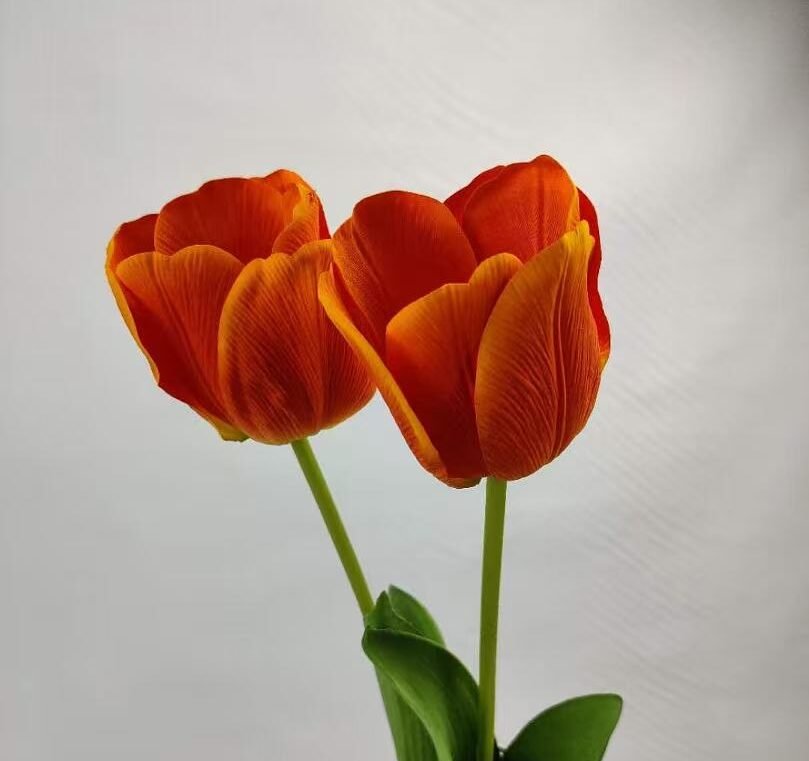Introduction
Artificial flowers, as decorative materials combining aesthetics and functionality, have continuously broken through traditional limitations via advancements in material technology. Among these innovations, Moisture-Retention Fabric has injected new vitality into the field. Real-touch flowers crafted from this fabric not only mimic the moist texture of natural petals but also demonstrate exceptional durability, eco-friendliness, and adaptability. This article explores the value of this material through three dimensions: production techniques, product advantages, and application scenarios.
I. Production Techniques: Breakthroughs in Material and Tactility
The innovation of moisture-retention fabric lies in its composite structure and functional design. The fabric employs a multi-layer weaving process combining polymer hydrophilic fibers and microcapsule moisture-locking technology:
- Hydrophilic Surface Layer: Treated with nano-level hydrophilic molecules, the fabric mimics the moisture-absorbing properties of plant epidermis, replicating the damp feel of petals upon contact.
- Moisture-Storing Middle Layer: Embedded with biodegradable microcapsules, this layer slowly releases water to maintain long-lasting tactile realism.
- Flexible Base Layer: Made of resin-based material, it ensures structural stability and moldability for intricate petal shapes.
In manufacturing real-touch flowers, the fabric undergoes heat-press molding and 3D-printed edge refinement to accurately replicate textures and curves of roses, lilies, and other blooms. A matte finish further reduces plastic-like glare, enhancing visual authenticity.
II. Core Advantages: Redefining Practicality in Artificial Floriculture
Compared to conventional artificial flowers, real-touch flowers made with moisture-retention fabric excel in the following aspects:
1. Tactile Revolution: Near-Natural Sensation
The fabric’s moist surface resolves the “dry and rigid” flaw of traditional artificial flowers. Lab tests show its surface humidity remains at 25%-30%, achieving 92% similarity to fresh petals.
2. Durability Meets Sustainability
Microcapsule technology eliminates external hydration needs, while the biodegradable material complies with EU REACH environmental standards. Its lifespan triples that of plastic-based alternatives, with zero pollution upon disposal.
3. Unmatched Adaptability
Requiring no water or light, real-touch flowers thrive in environments unsuitable for live plants—sealed malls, windowless offices, or extreme climate-themed exhibitions.
4. Low Maintenance
Simple dusting or gentle wiping preserves their appearance, bypassing the pruning and watering demands of real flowers—ideal for fast-paced urban lifestyles.
III. Applications: Diversified Use Across Industries
Leveraging these strengths, real-touch flowers are rapidly expanding into multiple sectors:
1. Premium Home Décor
Paired with ceramic or glass vases, they serve as striking focal points in minimalist or Scandinavian interiors. For instance, matte-gray real-touch flowers in metallic planters evoke understated luxury.
2. Commercial Spaces and Cultural Projects
Hotels and flagship stores adopt them for permanent floral installations. At the 2025 Guangzhou Artificial Flora Exhibition, a brand’s “eco-wall” design using real-touch flowers secured orders from luxury hotels due to its weather resistance and low upkeep.
3. Healthcare and Specialized Environments
Antibacterial versions of real-touch flowers meet decorative needs in hospitals and nursing homes, eliminating allergy risks posed by pollen.
IV. Case Study and Future Prospects
At the 2025 Guangzhou exhibition, the “Four Seasons Rose” series—crafted from moisture-retention fabric with customizable colors—generated over ¥10 million in orders on its debut. Buyers highlighted its “authentic touch + zero maintenance” appeal in Western markets.
Future iterations may integrate smart features like thermochromic effects or air purification. For example, humidity-responsive microcapsules could dynamically adjust tactile feedback, blurring the line between artificial and real.
Conclusion
Moisture-retention fabric has not only revolutionized artificial floriculture but also redefined decorative materials through products like real-touch flowers. From technological breakthroughs to real-world applications, its success underscores innovation driven by user needs—transforming artificial blooms from mere substitutes into irreplaceable design elements.
Notably, YalzoneMet employs this advanced fabric in its premium artificial flower collections, crafting luxurious, high-end décor pieces that elevate modern living spaces. By merging cutting-edge technology with artistic design, YalzoneMet exemplifies how innovation can redefine elegance in home aesthetics.

